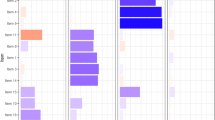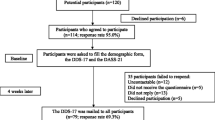Abstract
Background
Diabetes-related distress is the emotional burden and worries while managing chronic disease like diabetes. It remains mostly undetected because most patients do not realize their emotional problems. Diabetes distress affects glycemic control and makes the patient more prone to complications. Diabetes Distress Scale (DDS-17) developed by Polonsky is widely used to measure the diabetes distress in different part of the world.
Objective
To translate the DDS-17 into Hindi and validate the DDS-17 (H) among adult patients with type 2 diabetes in India.
Methods
The DDS-17 was translated to Hindi and back translated by independent bilingual translators. Face and content validity of the scale was evaluated with subject experts and a sample of the target population. A cross-sectional validation study was conducted for analyzing construct, convergent validity, and reliability of DDS-17 (H). Eligible participants were enrolled from the field practice area of a tertiary care hospital.
Results
The Content Validity Index of the scale was 0.99 and the Content Validity Ratio was 1, which was significant. Exploratory factor analysis of items supported a four-factor solution. Cronbach’s α coefficient for the scale was 0.958. The scale had a positive correlation with Depression Anxiety Stress Scale (DASS 21), p = 0.78, p < 0.000. Among the 200 enrolled participants, DDS-17 (H) assessed 18.5% of participants with moderate diabetes distress and 16.5%, high diabetes distress.
Conclusion
The DDS-17 is found to be valid and reliable in the Hindi language and can be used for early identification of diabetes distress in primary care settings.
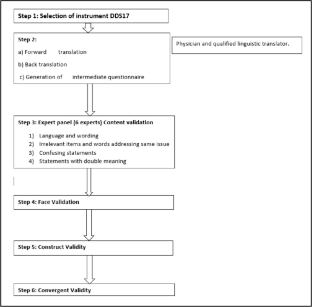
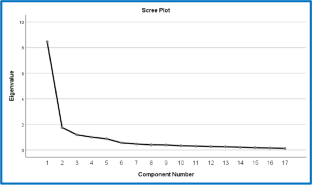
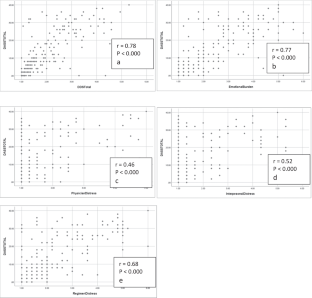
Similar content being viewed by others
References
Fisher L, Glasgow RE, Mullan JT, Skaff MM, Polonsky WH. Development of a brief diabetes distress screening instrument. Ann Fam Med. 2008;6(3):246–52.
Polonsky WH, Fisher L, Earles J, Dudl RJ, Lees J, Mullan J, et al. Assessing psychosocial distress in diabetes: development of the diabetes distress scale. Diabetes Care. 2005;28(3):626–31.
Lee EH, Lee YW, Lee KW, Kim YS, Nam MS. Measurement of diabetes-related emotional distress using the problem areas in diabetes scale: psychometric evaluations show that the short form is better than the full form. Health Qual Life Out. 2014;12:1–9.
Herschbach P, Duran G, Waadt S, Zettler A, Amm C, Marten-Mittag B, Strian F. Psychometric properties of the questionnaire on stress in patients with diabetes—Revised (QSD-R). Health Psychol. 1997;16(2):171.
Krzeminska S, Bak E. Psychometric properties of the polish version of the diabetes distress scale (DDS). Psychol Res Behav Manag. 2021;14:1149–56.
Martinez-Vega IP, Doubova SV, Aguirre-Hernandez R, Infante-Castañeda C. Adaptation and validation of the Distress Scale for Mexican patients with type 2 diabetes and hypertension: a cross-sectional survey. BMJ Open. 2016;6(3): e009723.
Fukuda N, Gandhi K, Lim E, Leake A. Validation of the diabetes distress scale in an Asian Pacific Islander population. Hawai’i Journal of Medicine & Public Health. 2019;78(1):3.
Curcio R, Maria Costa Alexandre N, de CarvalhoTorres H, HelenaMeloLima M. Translation and adaptation of the “Diabetes Distress Scale-DDS” in Brazilian culture. Acta Paulista de Enfermagem. 2012;25:762–7.
Chew B, Mukhtar F, Sherina M, Paimin F, Hassan N, Jamaludin N. The reliability and validity of the Malay version 17-item Diabetes Distress Scale. Malaysian Fam Physician Off J Acad Fam Physicians Malaysia. 2015;10(2):22.
Farm BAS, Perwitasari DA, Thobari JA, Cao Q, Krabbe PFM, Postma MJ. Translation, revision, and validation of the diabetes distress scale for Indonesian type 2 diabetic outpatients with various types of complications. Value in health regional issues. 2017;1(12):63–73.
Bharti Jain / TNN / Updated: Jun 28 2018. Hindi mother tongue of 44% in India, Bangla second most spoken: India News - Times of India [Internet]. TOI; [cited 2024 Apr 17]. Available from: https://timesofindia.indiatimes.com/india/hindi-mother-tongue-of-44-in-india-bangla-second-most-spoken/articleshow/64755458.cms.
Part XVII official language [Internet]. Ministry of External Affairs; [cited 2024 Apr 17]. Available from: https://www.mea.gov.in/Images/pdf1/Part17.pdf.
Sattar N, Rawshani A, Franzen S, et al. Age at diagnosis of type 2 diabetes mellitus and associations with cardiovascular and mortality risks. Circulation. 2019;139:2228–37.
Arafat S. Validation study can be a separate study design. Int J Med Sci Public Heal. 2016;5(11):2421.
Kumar K, Kumar S, Mehrotra D, Tiwari S, Kumar V, Dwivedi R. Reliability and psychometric validity of Hindi version of Depression, Anxiety and Stress Scale-21 (DASS-21) for Hindi speaking Head Neck Cancer and Oral Potentially Malignant Disorders Patients. J Cancer Res Ther. 2019;15(3):653–8.
Ayre C, Scally AJ. Critical values for Lawshe’s content validity ratio: revisiting the original methods of calculation. Meas Eval Couns Dev. 2014;47(1):79–86.
Hill BD. The sequential Kaiser-Meyer-Olkin procedure as an alternative for determining the number of factors in common-factor analysis: A Monte Carlo simulation. Oklahoma State University; 2011.
Silva DL, Sabino LD, Lanuza DM, Adina EM, Villaverde BS, Pena EG. Silva’s management competency theory: a factor-item analytic approach utilizing oblique rotation direct oblimin method under Kaiser-Bartlett’s test of sphericity. In Proceedings of the World Congress on Engineering and Computer Science 2014 Oct (Vol. 1).
Hair JF, Black B, Babin BJ, Anderson RE. Multivariate data analysis: Global edition. 7th ed. Harlow: Pearson Education; 2010.
Gahlan D, Rajput R, Gehlawat P, Gupta R. Prevalence and determinants of diabetes distress in patients of diabetes mellitus in a tertiary care centre. Diabetes Metab Syndr. 2018;12(3):333–6.
Thanakwang K, Thinganjana W, Konggumnerd R. Psychometric properties of the Thai version of the Diabetes Distress Scale in diabetic seniors. Clin Interv Aging. 2014;9:1353.
Ting RZ, Nan H, Yu MW, Kong AP, Ma RC, Wong RY, et al. Diabetes-related distress and physical and psychological health in Chinese type 2 diabetic patients. Diabetes Care. 2011;34(5):1094–6.
Chew BH, Mukhtar F, Sherina MS, Paimin F, Hassan NH, Jamaludin NK. The reliability and validity of the Malay version 17-item Diabetes Distress Scale. Malaysian family physician: the official journal of the Academy of Family Physicians of Malaysia. 2015;10(2):22.
Acknowledgements
We thank Mrs. Neera Tiwari, Senior Hindi Officer, AIIMS Rishikesh, and Mr. Pankaj Punjoth, Diabetes educator, AIIMS Rishikesh, for assistance with the translation of the DDS-17 scale.
Author information
Authors and Affiliations
Contributions
The authors confirms the contribution for the following: study conception and design, data collection, analysis and interpretation of results, and manuscript preparation.
Corresponding author
Ethics declarations
Competing interests
The authors declare no competing interests.
Ethical clearance
Ethical approval was obtained from the Institutional Ethics Committee of AIIMS Rishikesh: AIIMS/IEC/20/362.
Additional information
Publisher's Note
Springer Nature remains neutral with regard to jurisdictional claims in published maps and institutional affiliations.
Rights and permissions
Springer Nature or its licensor (e.g. a society or other partner) holds exclusive rights to this article under a publishing agreement with the author(s) or other rightsholder(s); author self-archiving of the accepted manuscript version of this article is solely governed by the terms of such publishing agreement and applicable law.
About this article
Cite this article
M., A., Khapre, M., Kant, R. et al. Diabetes-related distress: translation and validation of the Hindi version of Diabetes Distress Scale (DDS) for Indian type 2 diabetes mellitus patients. Int J Diabetes Dev Ctries (2024). https://doi.org/10.1007/s13410-024-01338-0
Received:
Accepted:
Published:
DOI: https://doi.org/10.1007/s13410-024-01338-0


